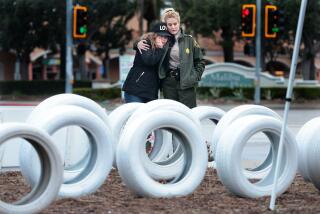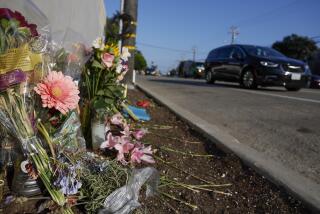Safeguards on Deadly California 126 Seem to Be Working
- Share via
FILLMORE — No one has died on California 126 in the 12 days since officials unveiled a gamut of measures to cut the carnage in response to rising public outrage.
And for the pretty, yet deadly, stretch of asphalt between Santa Paula and Santa Clarita that claimed 11 lives in five weeks, no news has indeed been good news.
Almost three weeks have passed since Fillmore Fire Chief Pat Askren last roused Mayor Roger Campbell from bed with word of the latest fatality. It’s been almost three weeks since the cacophony of squealing tires, the sickening crunch of metal on metal and the ominous shriek of ambulance sirens have filled the air.
And it’s been almost three weeks since many drivers finally realized that they could no longer speed with impunity on a lightly populated, sparsely patrolled section of rural road between two freeways that locals have labeled “Blood Alley.”
Improved safeguards, including more warning signs, lower speed limits in two highway construction zones east of Fillmore and tougher enforcement of traffic laws--as well as heightened public awareness of the unforgiving road--helped staunch the human toll.
“I think without a doubt it’s saved lives,” said Campbell, who worked with state legislators to secure the changes. “I believe the road is safer now. It still has a long way to go.”
The law enforcement officers who enforce the speed limits have seen motorists’ speeds plummet. Officers virtually blanketed the road again Wednesday in what is becoming their routine.
California Highway Patrol Officer George Orozco monitored the road-widening projects east of Fillmore that are ultimately intended to save lives but have played a role in five of the 11 deaths.
A motorcycle officer nicknamed “The Hammer” by fellow cops--for his skill at nailing speeding motorists--made sure that he was stationed where Orozco wasn’t. And an officer in an unmarked car watched for violations by the big-rig trucks that ply the route.
In addition, two CHP officers, rather than the usual one, have been assigned to patrol California 126. And as of Monday, the Santa Clarita CHP office designated an officer to patrol the stretch of highway just east of the Ventura County line.
The crackdown may be creating a safer highway, but officers still have no trouble finding motorists who deserve a ticket.
Wednesday morning, Los Angeles County-based CHP Officer Andy Hernandez gave a westbound Bakersfield woman a speeding ticket as she dived into a curve at 69 mph just before the easternmost construction zone. The woman claimed that the speedometer of her company car wasn’t working.
“It’s unfortunate; I don’t speed,” she said tartly.
Wearing a blue bow tie, a wry smile and a glint in his eye, 30-year-old Mark Hodges--alias “The Hammer”--found 12 scofflaws worthy of a ticket in just four hours to add to the estimated 11,000 tickets he has written in nine years on the job.
“He’s in his own class,” Orozco said. “He’s a ticket machine.”
And Orozco pulled over 21-year-old Heather Frye of Valencia as she headed home along the highway west of Fillmore at a brisk 71 mph with her husband, en route from a one-year anniversary vacation in Monterey.
Failing to adjust to the lower, 55-mph speed limit on the highway (45 mph in the construction zones) after freeway driving is among the leading reasons that motorists receive a ticket, Orozco said.
Inattention to the road--as demonstrated by the Ventura man zipping along at 73 mph while talking on his cellular phone--is another. Orozco stopped him a few minutes later. Such carelessness can lead to a driver inadvertently crossing double yellow lines and causing the sort of head-on collision that is the road’s hallmark.
“When you’re involved in a fatal accident, you don’t get a second chance,” Orozco said. “So it’s our job to bring them out of those habits and make them a little more accountable.”
The extra police and the state Department of Transportation’s decision to add more signs and push back concrete barriers that had narrowed the highway’s lanes have been met with support by the public, Orozco and Campbell said.
Orozco reports drivers honking and waving when they drive past after he has stopped a particularly errant motorist. Campbell said he has had more people thank him for his efforts to make the highway safer than any other issue he has dealt with in his long political career.
Campbell is so pleased with the improvements that he has lifted the ban he placed on himself, his wife, 19-year-old son and 21-year-old daughter from traveling on the highway east of Fillmore.
But he still wants Caltrans to complete the road construction along both stretches by the end of this year, rather than the December 1998 target date for the 5.4-mile stretch between Piru and the county line.
“I think Caltrans will save money,” he said. “There’s a major liability issue here with the construction zone. . . . The construction zone is the worst and most dangerous I’ve ever seen.”
More to Read
Sign up for Essential California
The most important California stories and recommendations in your inbox every morning.
You may occasionally receive promotional content from the Los Angeles Times.










